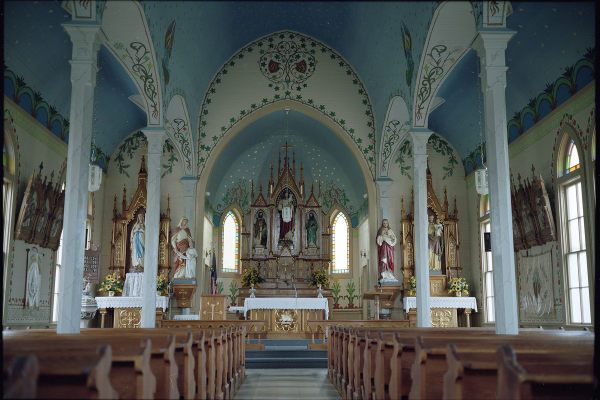Before Sloth Meant Laziness, It Was the Spiritual Sin of Acedia
And why early monks in the desert didn’t want to fall asleep during the day.

The seven deadly sins may seem familiar and, with that familiarity, less a matter of life and death and damnation. Sure, greed and envy aren’t great, but who hasn’t overindulged in this or that without grievous consequences? But when the list of Christian cardinal sins was first created, they were a big deal: eight of the biggest threats to a devout life as a monk in the desert. Eight? One among those that isn’t included among the sins today, called acedia, was perhaps the greatest threat of all to those monks.
Acedia comes from Greek, and means “a lack of care.” It sounds a little like today’s sloth, and acedia is indeed considered a precursor to today’s sin of laziness. To Christian monks in the fourth century, however, acedia was more than just laziness or apathy. It was more like dejection that made it difficult to be spiritual, avoiding ascetic practices, boredom that led to falling asleep while reading, and frustration with life in a monastery—but the meaning is nuanced and has changed over time. The evolution of the word’s use shows just how much the concept of cardinal sin has shifted through the centuries.
To Evagrius of Pontius, acedia was the most noteworthy of the eight vices that he felt could tempt monks to abandon their religious lives. The Greek monk listed gluttony, fornication, avarice, sadness, anger, vainglory, pride, and acedia as threats to devout monasticism in Of the Eight Capital Sins, but argued that acedia was “the last of the sins to conquer.” Overcoming the other seven didn’t mean a monk was safe, but overcoming acedia, according to Evagrius, brought one closer to God.

Evagrius was a member of the Desert Fathers and Mothers, a group of devout Christian monks and hermits who lived in the Egyptian desert beginning in the third century. By the time Evagrius joined their ranks in the late 300s, there were several thousand monks living in organized communities. They spent their days fasting, working, and worshipping, often in isolation. When the sun and the heat peaked, life could be quite uncomfortable. So it makes sense that Evagrius dubbed acedia the “demon of noontide,” a reference to Psalm 91. Siegfried Wenzel, in his book The Sin of Sloth: Acedia in Medieval Thought and Literature, wrote that “in the end acedia causes the monk to either give in to physical sleep, which proves unrefreshing or actually dangerous because it opens the door to many other temptations, or to leave his cell and eventually the religious life altogether.” Acedia could be resisted, but only through endurance, prayer, and sometimes even crying.
John Cassian, a student of Evagrius’s, translated the list of eight sins to Latin and his writings on the subject helped spread the concept of the cardinal sins beyond the Desert Fathers. But as soon as acedia left the desert, the demon of noontide started to become a whole different animal.
The first major edit of the original list happened in the 6th century, when Pope Gregory I shortened it to the seven deadly sins that track roughly what we’re familiar with today. He lumped acedia in with another vice, tristitia, or sorrow. The two terms were often used interchangeably until sloth became a more common catch-all. At issue was whether acedia and tristitia were still just concerns for solitary monks, and how dangerous they really were for laypeople.

Even in the Middle Ages monks still struggled to define and clarify acedia. Peter Damiani, a Benedictine monk in the eleventh century, addressed the vice in some of his writings, where “acedia almost amounts to heaviness of the eyelids,” wrote Wenzel. St. Rodulpus, according to Damiani, fought acedia by “tying ropes to the ceiling of his cell, putting his arms through, and singing the psalms.” St. Bernard of Clairvaux agreed with Evagrius’s definition of acedia (as, essentially, the temptation of midday siestas), while Adam of Perseigne felt acedia was an aversion to physical discomfort. Others likened it to a “spiritual loathing” or “inner emptiness.”
Few of these interpretations of acedia made much sense outside the desert or the cloisters. Thomas Aquinas’s definition of sloth in the thirteenth century still carries the connotations of acedia—a spiritual affliction—but it’s clear by then that monks aren’t the only ones affected. Sloth, he wrote, “is sadness about one’s spiritual good.” Geoffrey Chaucer defined “Accidie” as indolence and idleness. Modern interpretations of acedia liken it to depression or ennui, though some religious groups view acedia and depression as separate maladies. The evolution of the sin, from a matter of spiritual inadequacy to the laziness of sloth, reflects the complexity of the history of Christianity and our conception of what is dangerous to the mind and soul.














Follow us on Twitter to get the latest on the world's hidden wonders.
Like us on Facebook to get the latest on the world's hidden wonders.
Follow us on Twitter Like us on Facebook